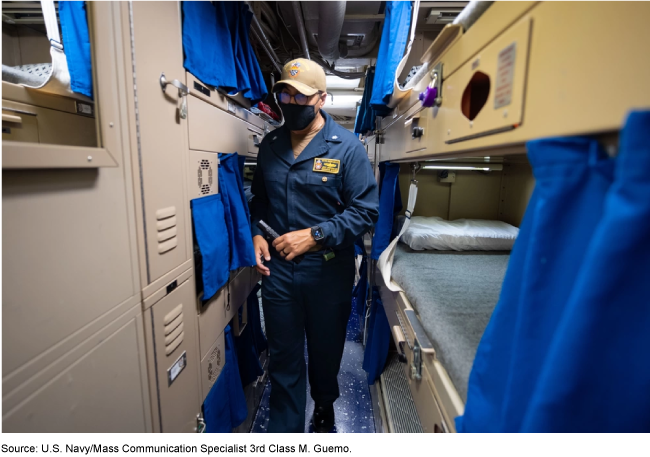Navy Readiness: Challenges to Addressing Sailor Fatigue in the Surface Fleet Continue
Fast Facts
Inadequate crew rest and fatigue is an ongoing problem for the Navy—one that's contributed to fatal ship collisions in the past.
In 2021 we made 8 recommendations to help the Navy address fatigue. As of September 2023, the Navy has implemented 4 of them—such as requiring the timely collection of data on fatigue so that officers can make informed decisions. But the Navy still has work to do on other issues we identified.
For example, many ships are understaffed—and heavy workloads are a contributing factor to fatigue. Until the Navy addresses crew shortfalls on ships, sailors will likely continue to have problems getting adequate sleep.
An executive officer conducts berthing inspections aboard a destroyer.

Highlights
What GAO Found
The Navy has completed actions to implement four of the eight recommendations GAO made in its May 2021 report (GAO-21-366). The Navy (1) revised its guidance to require the systematic collection of data on sailor fatigue, (2) revised guidance to use required positions when reporting crew sizes, (3) established risk-based crewing targets, and (4) used crew requirements to project future personnel needs. While the Navy has made progress in these areas, it has not fully taken action on the other four recommendations. Specifically, the Navy has yet to fund the expansion of two pilot programs that have been used to monitor sailor fatigue in real time and assist commanders with underway decision-making. Additionally, work remains to fully address the factors causing sailor fatigue and inadequate sleep, particularly crew shortfalls and uncomfortable mattresses. Lastly, the Navy has not yet accounted for additional sailor workload resulting from the continued implementation of its Ready Relevant Learning training initiative.
As required, in March 2023 the Navy reported to Congress on the status of its actions to monitor crew fatigue and ensure equitable fatigue management throughout the fleet. Specifically:
- The Navy's assessment showed that sailors continue to fall short of required sleep hours. For example, the surface force-wide average of 5.25 hours of sleep obtained falls below the standard of sailors having at least 7.5 hours available to sleep per day.
- The Navy's report states that it has mostly met its three goals for managing fatigue, however some obstacles remain. For example, ongoing crew shortfalls, limited real-time fatigue data, and persistent mattress problems prevent the Navy from more effectively managing fatigue in the surface fleet. Fully implementing GAO's recommendations will help the Navy address these obstacles.
Why GAO Did This Study
The National Defense Authorization Act for Fiscal Year 2022 required the Secretary of the Navy to implement each of GAO's recommendations from its May 2021 report. The act also required the Navy to report to Congress on the status of actions taken to monitor crew fatigue and ensure equitable fatigue management throughout the fleet. Lastly, the act includes a provision for GAO to report on the extent to which the Navy's fatigue management actions and goals address its recommendations.
This report describes the extent to which: (1) the Navy has implemented the May 2021 recommendations, (2) the Navy's report assesses the extent of crew fatigue throughout the surface fleet, and (3) the Navy's report identifies goals for effective fatigue management. GAO analyzed the Navy's report to Congress and related documentation and interviewed Navy officials.
For more information, contact Cary Russell at 202-512-5431 or russellc@gao.gov.
